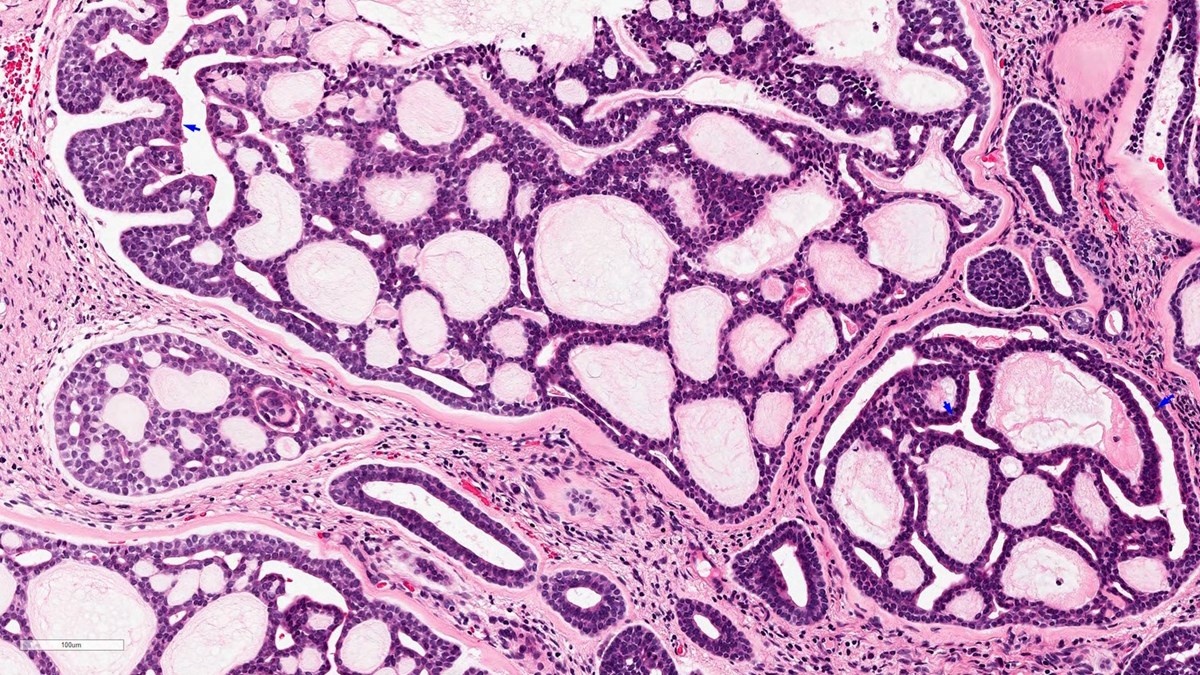Adenoid Cystic Carcinoma (ACC)
Adenoid cystic carcinoma (ACC)
Adenoid cystic carcinoma (ACC) is one of the more common types of salivary gland cancer. About one in ten of all salivary gland cancers are ACC (1). ACC most commonly occurs in people in their 40’s or 50’s, which is younger than most cancers. It is more common in women as about six in every ten people affected are women (1).
ACC is most likely to start in the major salivary glands located around the mouth and jaw, but it can also form in minor salivary glands found elsewhere in the head, throat, and windpipe. More rarely, ACC can form in glands similar to salivary glands like the tear glands, skin glands, and breast glands (1).
ACC is usually a slow growing cancer (also called indolent or low-grade). However, sometimes ACC does grow and spread much faster, and these ACC cancers are called high-grade.
Regardless of how quickly the ACC is growing, some ACCs are difficult to cure with surgery and/or radiotherapy. This type of cancer can have a high risk of returning later in life even with successful surgery. Sometimes this can be a long time, as late as 10 or 20 years after the surgery.
If ACC does come back, it can come back in the same place it was first removed from (local recurrence), or it can spread to other places (metastatic recurrence). It is possible for ACC to come back in both ways in the same person. ACC is most likely to spread to the lungs, but it can spread to anywhere within the body (1).
All cancers have characteristics called markers.
In ACC these can sometimes give information about how fast the cancer might grow. In particular, the cancer might have a change in a gene called NOTCH1, which causes it to become more active (commonly referred to as NOTCH1 gain of function). ACC with this change is usually high-grade (2).
Changes in another gene called TP53 can sometimes cause it to stop working (commonly referred to as TP53 loss of function). ACC with this gene change is usually high-grade too (3).
Most ACCs have a very particular genetic marker called a MYB:NFIB fusion. This can be useful in diagnosing ACC as it is only found in ACC and is thought to
be part of how ACC develops. There are similar, rarer fusions that might be found instead, like MYBL1:NFIB. As many as 90% of ACC have one of these markers (5).
Sometimes ACC has markers that can be targeted with drug treatments, but these are not common (4).
ACC is usually quite resistant to drug treatments that target cancers. As a result, the number of drug options to treat ACC are limited. This means that people with slow growing ACCs tend to be monitored with a “watch and wait” approach (active surveillance), and the drug treatments are saved in case the cancer becomes more troublesome (6).
The drug treatments commonly available in the UK include traditional chemotherapy and a targeted tablet therapy called Lenvatinib. Many people also receive experimental treatments in clinical trials.
However, when ACC is slow growing sometimes this means it can be treated with other methods. If the cancer is in very few places, normally 5 or less, then it might be possible to target these areas and control the cancer. Depending on where the cancer is, this might involve methods like surgery, radiotherapy, or radiofrequency ablation. These treatments intend to slow the cancer down and/or make it less troublesome (6;7).
Useful resources
Read more about how to get your tumour profiled and add to the research biobank at the Christie Hospital in Manchester, UK here:
- Gene profiling or tumour profiling or genomic testing - Salivary Gland Cancer UK
- Donate tissue to the Biobank - Salivary Gland Cancer UK
References:
1. Dillon PM, Chakraborty S, Moskaluk CA, Joshi PJ, Thomas CY. Adenoid cystic carcinoma: A review of recent advances, molecular targets, and clinical trials. Head Neck. 2016 Apr;38(4):620-7. doi: 10.1002/hed.23925. Epub 2015 Jun 16. PMID: 25487882; PMCID: PMC6166139
2. Feeney L, Hapuarachi B, Adderley H, et al. Clinical disease course and survival outcomes following disease recurrence in adenoid cystic carcinoma with and without NOTCH signaling pathway activation. Oral Oncol 2022;133:106028. doi:10.1016/j.oraloncology.2022.106028
3. Adderley H, Rack S, Hapuarachi B, et al. The utility of Tp53 and Pik3Ca mutations as prognostic biomarkers in salivary adenoid cystic carcinoma. Oral Oncol 2021;113:105095. doi:10.1016/j.oraloncology.2020.105095
4. Rack S, Feeney L, Hapuarachi B, Adderley H, Woodhouse L, Betts G, Burghel GJ, Harrington KJ, Metcalf R. Evaluation of the Clinical Utility of Genomic Profiling
to Inform Selection of Clinical Trial Therapy in Salivary Gland Cancer. Cancers. 2022; 14(5):1133. https://doi.org/10.3390/cancers14051133
5. Fujii K, Murase T, Beppu S, Saida K, Takino H, Masaki A, Ijichi K, Kusafuka K, Iida Y, Onitsuka T, Yatabe Y, Hanai N, Hasegawa Y, Inagaki H. MYB, MYBL1, MYBL2 and NFIB gene alterations and MYC overexpression in salivary gland adenoid cystic carcinoma. Histopathology. 2017 Nov;71(5):823-834. doi:10.1111/his.13281. Epub 2017 Aug 16. PMID: 28594149
6. van Herpen C, Vander Poorten V, Skalova A, Terhaard C, Maroldi R, van Engen A, Baujat B, Locati LD, Jensen AD, Smeele L, Hardillo J, Martineau VC, Trama A, Kinloch E, Even C, Machiels JP; ESMO Guidelines Committee. Electronic address: [email protected]. Salivary gland cancer: ESMO-European Reference Network on Rare Adult Solid Cancers (EURACAN) Clinical Practice Guideline for diagnosis, treatment and follow-up. ESMO Open. 2022 Dec;7(6):100602. doi:10.1016/j.esmoop.2022.100602. Epub 2022 Nov 2. Erratum in: ESMO Open. 2023 Oct;8(5):101630. doi:10.1016/j.esmoop.2023.101630.
7. Jessica L. Geiger et al., Management of Salivary Gland Malignancy: ASCO Guideline. JCO 39, 1909-1941(2021). DOI: https://doi.org/10.1200/JCO.21.00449
Last updated August 2024

